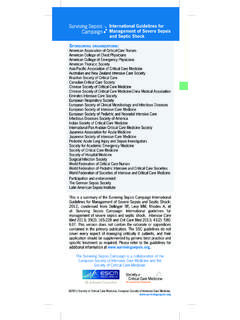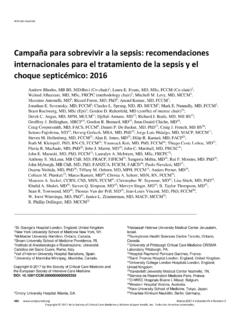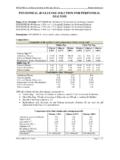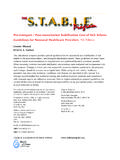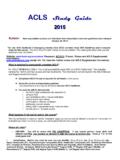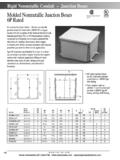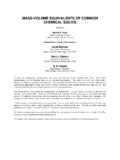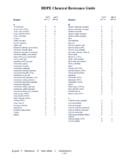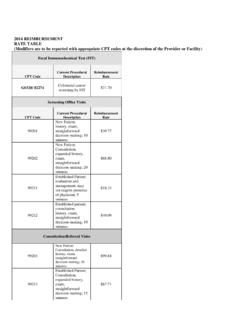Transcription of Recommendations: Other Suppo rtive Therapy of …
1 recommendations : Other Supportive Therapy of Severe Sepsis* K. Blood Product Administration 1. Once tissue hypoperfusion has resolved and in the absence of extenuating circumstances, such as myocardial ischemia, severe hypoxemia, acute hemorrhage, or ischemic heart disease, we recommend that red blood cell transfusion occur only when hemoglobin concentration decreases to < g/dL to target a hemoglobin concentration of g/dL in adults (grade 1B). 2. Not using erythropoietin as a specific treatment of anemia associated with severe sepsis (grade 1B).
2 3. Fresh frozen plasma not be used to correct laboratory clotting abnormalities in the absence of bleeding or planned invasive procedures (grade 2D). 4. Not using antithrombin for the treatment of severe sepsis and septic shock (grade 1B). 5. In patients with severe sepsis, administer platelets prophylactically when counts are <10,000/mm3 (10 x 109/L) in the absence of apparent bleeding. We suggest prophylactic platelet transfusion when counts are < 20,000/mm3 (20 x 109/L) if the patient has a significant risk of bleeding.
3 Higher platelet counts ( 50,000/mm3 [50 x 109/L]) are advised for active bleeding, surgery, or invasive procedures (grade 2D). L. Immunoglobulins 1. Not using intravenous immunoglobulins in adult patients with severe sepsis or septic shock (grade 2B). M. Selenium 1. Not using intravenous selenium for the treatment of severe sepsis (grade 2C). N. History of recommendations Regarding Use of rhAPC A history of the evolution of SSC recommendations as to rhAPC (no longer available) is provided. O. Mechanical Ventilation of Sepsis-Induced ARDS 1.
4 Target a tidal volume of 6 mL/kg predicted body weight in patients with sepsis-induced ARDS (grade 1A vs. 12 mL/kg). 2. Plateau pressures be measured in patients with ARDS and initial upper limit goal for plateau pressures in a passively inflated lung be 30 cm H2O (grade 1B). 3. Positive end-expiratory pressure (PEEP) be applied to avoid alveolar collapse at end expiration (atelectotrauma) (grade 1B). 4. Strategies based on higher rather than lower levels of PEEP be used for patients with sepsis-induced moderate or severe ARDS (grade 2C).
5 5. Recruitment maneuvers be used in sepsis patients with severe refractory hypoxemia (grade 2C). 6. Prone positioning be used in sepsis-induced ARDS patients with a Pao2/Fio2 ratio 100 mm Hg in facilities that have experience with such practices (grade 2B). 7. That mechanically ventilated sepsis patients be maintained with the head of the bed elevated to 30-45 degrees to limit aspiration risk and to prevent the development of ventilator-associated pneumonia (grade 1B). 8. That noninvasive mask ventilation (NIV) be used in that minority of sepsis-induced ARDS patients in whom the benefits of NIV have been carefully considered and are thought to outweigh the risks (grade 2B).
6 9. That a weaning protocol be in place and that mechanically ventilated patients with severe sepsis undergo spontaneous breathing trials regularly to evaluate the ability to discontinue mechanical ventilation when they satisfy the following criteria: a) arousable; b) hemodynamically stable (without vasopressor agents); c) no new potentially serious conditions; d) low ventilatory and end-expiratory pressure requirements; and e) low Fio2 requirements which can be met safely delivered with a face mask or nasal cannula.
7 If the spontaneous breathing trial is successful, consideration should be given for extubation (grade 1A). 10. Against the routine use of the pulmonary artery catheter for patients with sepsis induced ARDS (grade 1A). 11. A conservative rather than liberal fluid strategy for patients with established sepsis-induced ARDS who do not have evidence of tissue hypoperfusion (grade 1C). 12. In the absence of specific indications such as bronchospasm, not using beta 2-agonists for treatment of sepsis-induced ARDS (grade 1B).
8 P. Sedation, Analgesia, and Neuromuscular Blockade in Sepsis 1. Continuous or intermittent sedation be minimized in mechanically ventilated sepsis patients, targeting specific titration endpoints (grade 1B). 2. Neuromuscular blocking agents (NMBAs) be avoided if possible in the septic patient without ARDS due to the risk of prolonged neuromuscular blockade following discontinuation. If NMBAs must be maintained, either intermittent bolus as required or continuous infusion with train-of-four monitoring of the depth of blockade should be used (grade 1C).
9 3. A short course of NMBA of not greater than 48 hours for patients with early sepsis-induced ARDS and a Pao2/Fio2 < 150 mm Hg (grade 2C). Q. Glucose Control 1. A protocolized approach to blood glucose management in ICU patients with severe sepsis commencing insulin dosing when 2 consecutive blood glucose levels are >180 mg/dL. This protocolized approach should target an upper blood glucose 180 mg/dL rather than an upper target blood glucose 110 mg/dL (grade 1A). 2. Blood glucose values be monitored every 1 2 hrs until glucose values and insulin infusion rates are stable and then every 4 hrs thereafter (grade 1C).
10 3. Glucose levels obtained with point-of-care testing of capillary blood be interpreted with caution, as such measurements may not accurately estimate arterial blood or plasma glucose values (UG). R. Renal Replacement Therapy 1. Continuous renal replacement therapies and intermittent hemodialysis are equivalent in patients with severe sepsis and acute renal failure (grade 2B). 2. Use continuous therapies to facilitate management of fluid balance in hemodynamically unstable septic patients (grade 2D). S. Bicarbonate Therapy 1.
